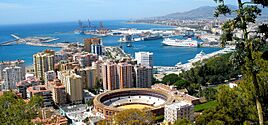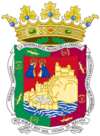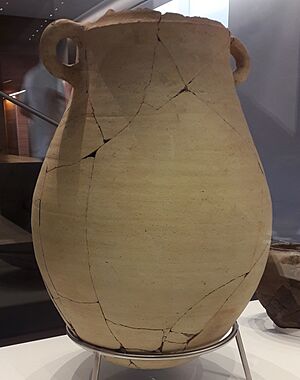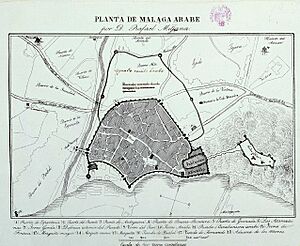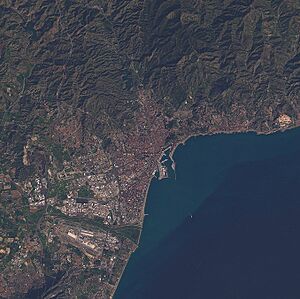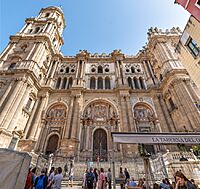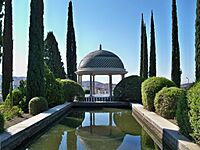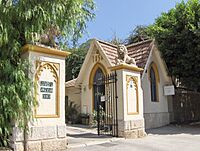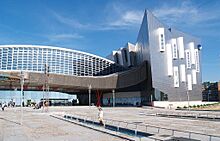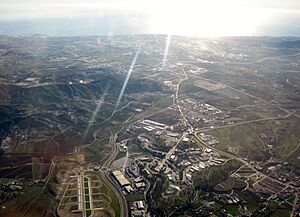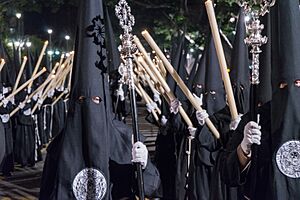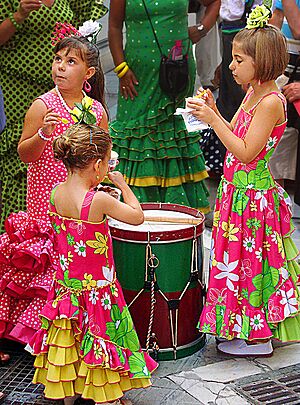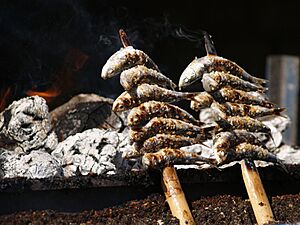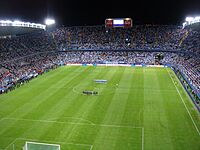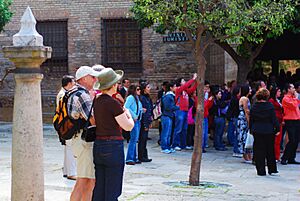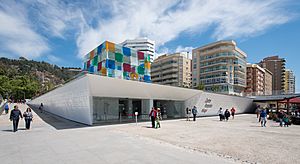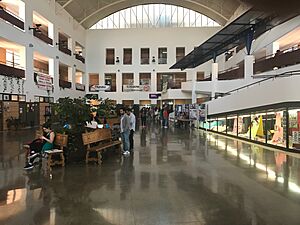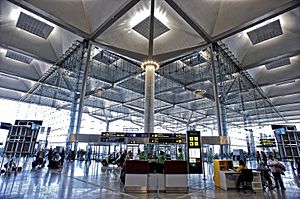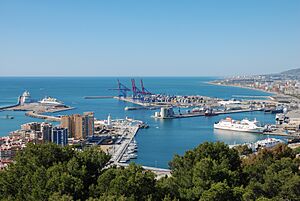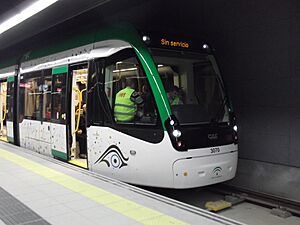Málaga facts for kids
Quick facts for kids
Málaga
|
|||
|---|---|---|---|
|
Panoramic view
El Cenachero
Calle Marqués de Larios
Botanical Garden
La Malagueta Beach
|
|||
|
|||
| Country | Spain | ||
| Autonomous community | Andalusia | ||
| Province | Málaga | ||
| Founded | 8th century BC | ||
| Government | |||
| • Type | Ayuntamiento | ||
| • Body | City Council of Málaga | ||
| Area | |||
| • Municipality | 398 km2 (154 sq mi) | ||
| • Urban | 827 km2 (319 sq mi) | ||
| Elevation | 11 m (36 ft) | ||
| Population
(2018)
|
|||
| • Municipality | 571,026 | ||
| • Rank | 6th | ||
| • Density | 1,434.7/km2 (3,716/sq mi) | ||
| • Urban | 967,250 | ||
| GDP | |||
| • Metro | €28.244 billion (2020) | ||
| Time zone | UTC+1 (CET) | ||
| • Summer (DST) | UTC+2 (CEST) | ||
| Postcode |
29001-29018
|
||
| Calling code | +34 (Spain) 95 (Málaga) | ||
Málaga is a large city in southern Spain. It is the capital of the Province of Málaga in the region of Andalusia. With over 578,000 people in 2020, it is the second-biggest city in Andalusia and the sixth-biggest in Spain. Málaga is located on the Costa del Sol ("Coast of the Sun") along the Mediterranean Sea.
The city has a very long history, going back about 2,800 years. This makes it one of the oldest cities in Western Europe where people have lived continuously. It was first founded around 770 BC by the Phoenicians. Over time, it was ruled by different groups, including the Carthaginians, Romans, Visigoths, and Byzantines. In the 8th century, it came under Islamic rule. Later, in 1487, the Crown of Castile took control during the Granada War.
Today, Málaga is an important city for tourism, building, and technology. It has become a major tech hub, with many companies in the Málaga TechPark. It is also home to Unicaja, one of the region's largest banks. Málaga is well-connected by the Málaga–Costa del Sol Airport, the Port of Málaga, and a high-speed train network.
Contents
Exploring Málaga's Past
Málaga's story began around 770 BC. Phoenicians from Tyre founded a settlement called Málaka. This town was important for trade between Phoenicia and the Strait of Gibraltar. It controlled access to the Guadalmedina River.
Later, in the 6th or 5th century BC, the city came under the rule of Carthage. After the Punic Wars, the Roman Republic took over. The Romans called the town Malaca. During this time, a Roman theatre was built.
After the Western Roman Empire fell, Málaga was ruled by the Visigoths. Around 552 AD, the Byzantine Empire took control. They improved the docks, which helped the city's fishing and trading. In 615, the Visigoths took the city back.
Islamic Rule and Growth
In 711 or 713, Arab and Berber forces brought Málaga under Islamic rule. The city, known as Mālaqah, became more important after 930 under the Caliphate of Córdoba. It replaced Archidona as the capital of the Rayya region. Málaga was famous for its vineyards and high-quality raisins.
In the 11th century, Málaga became the center of the Hammudid kingdom, known as the taifa of Málaga. The famous traveler Ibn Battuta visited around 1325. He described Málaga as "one of the largest and most beautiful towns of Andalusia." He praised its grapes, figs, almonds, and pomegranates. The city also exported "excellent gilded pottery."
After the Nasrid Kingdom of Granada was formed in the 13th century, Málaga became its main port. It traded silk, dried nuts (like raisins and almonds), wine, and leather. By the 15th century, about 15,000 people lived in Málaga.
Christian Conquest and Modern Times
Christian forces took Málaga on August 18, 1487, after a long siege. Most of the Muslim residents became captives. The city was then settled by Christian people from other parts of Spain. Málaga continued to be an important trading center.

In the early 19th century, Málaga started to become industrialized. The city's population grew steadily. However, in the late 1800s, an economic crisis caused by a grapevine pest called Phylloxera led to a decrease in population.
In 1924, the coastal town of Torremolinos became part of Málaga. During the Spanish Civil War (1936-1939), Málaga was controlled by the Second Spanish Republic. After a change of control in February 1937, many people tried to leave the city.
Torremolinos grew into a popular international tourist spot in the 1950s and 1960s. It became known as a welcoming place for the LGBT community. In 1988, Torremolinos became its own separate municipality.
Málaga's Natural Setting
Where Málaga is Located
Málaga is in the south of Spain, on the Costa del Sol (meaning "Coast of the Sun"). It is on the northern side of the Alboran Sea, which is the western part of the Mediterranean Sea. The city is about 100 kilometers (62 miles) east of the Strait of Gibraltar. It is also about 130 kilometers (81 miles) north of Africa.
The Montes de Málaga mountain range is in the northeast of the city. The highest point there is Pico Reina, which is 1,031 meters (3,383 feet) above sea level.
The city center is near where the Guadalmedina river meets the sea. The Guadalhorce river also flows into the Mediterranean west of the city. The Gibralfaro is a 130-meter (427-foot) high hill. The Gibralfaro Castle and the Alcazaba fortress sit on this hill, overlooking the city.
Málaga's Sunny Climate
Málaga has a hot-summer Mediterranean climate. This means it has mild winters with some rain and hot summers with very little rain. The city enjoys lots of sunshine, with about 300 sunny days each year. Only about 40 to 45 days have rain.
Málaga has some of the warmest winters of any big city in Europe. The average daytime temperature from December to February is around 17–18°C (63–64°F). The Málaga Mountains help block cold winds from the north in winter.
The average yearly temperature is 23.3°C (73.9°F) during the day and 13.7°C (56.7°F) at night. In January, the coldest month, temperatures range from 14 to 20°C (57–68°F) during the day. In August, the warmest month, temperatures range from 26 to 34°C (79–93°F) during the day.
Snowfall is very rare in Málaga. It has only snowed once in the city since the 1900s, on February 2, 1954.
| Climate data for Málaga Airport (AGP), Churriana (1981–2010), Extremes (1942-present) | |||||||||||||
|---|---|---|---|---|---|---|---|---|---|---|---|---|---|
| Month | Jan | Feb | Mar | Apr | May | Jun | Jul | Aug | Sep | Oct | Nov | Dec | Year |
| Record high °C (°F) | 26.8 (80.2) |
30.0 (86.0) |
31.4 (88.5) |
33.0 (91.4) |
35.0 (95.0) |
41.0 (105.8) |
44.2 (111.6) |
44.0 (111.2) |
40.0 (104.0) |
36.3 (97.3) |
30.4 (86.7) |
29.9 (85.8) |
44.2 (111.6) |
| Mean daily maximum °C (°F) | 16.8 (62.2) |
17.7 (63.9) |
19.6 (67.3) |
21.4 (70.5) |
24.3 (75.7) |
28.1 (82.6) |
30.5 (86.9) |
30.8 (87.4) |
28.2 (82.8) |
24.1 (75.4) |
20.1 (68.2) |
17.5 (63.5) |
23.3 (73.9) |
| Daily mean °C (°F) | 12.1 (53.8) |
12.9 (55.2) |
14.7 (58.5) |
16.3 (61.3) |
19.3 (66.7) |
23.0 (73.4) |
25.5 (77.9) |
26.0 (78.8) |
23.5 (74.3) |
19.5 (67.1) |
15.7 (60.3) |
13.2 (55.8) |
18.5 (65.3) |
| Mean daily minimum °C (°F) | 7.4 (45.3) |
8.2 (46.8) |
9.8 (49.6) |
11.1 (52.0) |
14.2 (57.6) |
18.0 (64.4) |
20.5 (68.9) |
21.1 (70.0) |
18.8 (65.8) |
15.0 (59.0) |
11.3 (52.3) |
8.9 (48.0) |
13.7 (56.7) |
| Record low °C (°F) | −2.6 (27.3) |
−3.8 (25.2) |
−1.2 (29.8) |
2.8 (37.0) |
5.0 (41.0) |
12.8 (55.0) |
14.0 (57.2) |
15.2 (59.4) |
10.2 (50.4) |
5.6 (42.1) |
1.4 (34.5) |
−0.8 (30.6) |
−3.8 (25.2) |
| Average precipitation mm (inches) | 69 (2.7) |
60 (2.4) |
52 (2.0) |
44 (1.7) |
20 (0.8) |
6 (0.2) |
0 (0) |
6 (0.2) |
20 (0.8) |
57 (2.2) |
100 (3.9) |
100 (3.9) |
534 (21.0) |
| Average precipitation days (≥ 1 mm) | 6 | 5 | 4 | 5 | 3 | 1 | 0 | 1 | 2 | 4 | 6 | 7 | 42 |
| Average relative humidity (%) | 69 | 68 | 67 | 63 | 59 | 58 | 58 | 61 | 65 | 70 | 71 | 72 | 65 |
| Mean monthly sunshine hours | 180 | 180 | 222 | 244 | 292 | 329 | 347 | 316 | 255 | 215 | 172 | 160 | 2,905 |
| Source: Agencia Estatal de Meteorología | |||||||||||||
| Climate data for Málaga | |||||||||||||
|---|---|---|---|---|---|---|---|---|---|---|---|---|---|
| Month | Jan | Feb | Mar | Apr | May | Jun | Jul | Aug | Sep | Oct | Nov | Dec | Year |
| Average sea temperature °C (°F) | 15.9 (60.7) |
15.6 (60.0) |
15.6 (60.0) |
16.8 (62.2) |
18.4 (65.2) |
21.0 (69.7) |
22.9 (73.2) |
23.5 (74.3) |
21.9 (71.3) |
20.5 (68.8) |
18.1 (64.5) |
16.5 (61.8) |
18.9 (66.0) |
| Mean daily daylight hours | 10.0 | 11.0 | 12.0 | 13.0 | 14.0 | 15.0 | 14.0 | 14.0 | 12.0 | 11.0 | 10.0 | 10.0 | 12.2 |
| Average Ultraviolet index | 2 | 4 | 5 | 7 | 8 | 10 | 10 | 9 | 7 | 5 | 3 | 2 | 6 |
| Source: Weather Atlas | |||||||||||||
City Areas and Districts
Málaga is divided into 11 main areas called municipal districts.
| Nº | District | Nº | District | Location |
|---|---|---|---|---|
| 1 | Centro | 7 | Carretera de Cádiz |  |
| 2 | Este | 8 | Churriana | |
| 3 | Ciudad Jardín | 9 | Campanillas | |
| 4 | Bailén-Miraflores | 10 | Puerto de la Torre | |
| 5 | Palma-Palmilla | 11 | Teatinos-Universidad | |
| 6 | Cruz de Humilladero |
Top Places to Visit
Málaga's old city center is next to the harbor. Mountains surround it to the north. Two rivers, the Guadalmedina and the Guadalhorce, flow nearby.
The oldest buildings in the city are parts of the Phoenician walls. You can see them in the cellar of the Museo Picasso Málaga. The Roman theatre, built in the 1st century BC, was found again in 1951.
The Moors (Islamic rulers) built the impressive Castle of Gibralfaro. It is connected to the Alcazaba, which was a fortress and royal home. Both were built between the 11th and 14th centuries. The Alcazaba sits on a hill and once protected the city from pirates. It has strong walls and towers.
The Church of Santiago is a great example of Mudéjar style. This style mixes Christian and Islamic designs. The Iglesia del Sagrario was built on the site of an old mosque. It has a beautiful, detailed entrance.
The Cathedral and the Episcopal Palace started with Renaissance designs. They were finished in the more decorative Baroque style. The Basílica y Real Santuario de Santa María de la Victoria has a chapel with amazing Baroque plasterwork.
Other interesting places to see include:
- Old city walls from different time periods.
- Various historic churches like the Church of the Sacred Heart and Church of the Holy Martyrs.
- La Concepción, a beautiful botanical and historical garden.
- Atarazanas Market.
- Anglican Cemetery of St. George, the oldest non-Catholic Christian cemetery in mainland Spain.
- The palm grove and Muelle Uno at the Port of Málaga.
- La Malagueta bullring.
- Pedregalejo, an old fishing neighborhood.
- Calle Marques de Larios, the main shopping street.
People of Málaga
| Nationality | Population |
|---|---|
| 9,754 | |
| 4,627 | |
| 3,650 | |
| 3,575 | |
| 2,715 | |
| 2,137 | |
| 1,968 | |
| 1,823 | |
| 1,805 | |
| 1,732 | |
| 1,032 | |
| 1,030 | |
| 973 | |
| 918 | |
| 841 |
In 2018, Málaga had a population of 571,026 people. Most were Spanish citizens, but about 43,563 were from other countries. The number of people from other countries living in Málaga has grown a lot since the 1970s. In 2020, there were 50,080 foreign residents.
Málaga's Wider Area

The urban area of Málaga stretches along the coast. It has a population of over 1 million people. This area includes Málaga itself and nearby towns like Rincón de la Victoria, Torremolinos, Benalmádena, Fuengirola, Alhaurín de la Torre, Mijas, Marbella, and San Pedro Alcántara.
The larger Málaga metropolitan area includes even more towns. These are mostly in the mountains north of the coast. About 1.3 million people live in the Málaga metropolitan area. This number grows every year as more people move to the region.
Málaga's Economy
Málaga is the fourth-biggest city in Spain for economic activity. It is behind only Madrid, Barcelona, and Valencia.
The most important businesses in Málaga are tourism, construction, and technology services. Other areas like transportation and logistics are also growing. The Andalusia Technology Park (PTA) is in Málaga. It has grown a lot since it opened in 1992. In 2018, over 16,774 people worked there.
Málaga wants to be known as a global business hub. It focuses on new technologies, innovation, and research. Tourism is a big part of the city's income. This is thanks to its airport, better transport, and new cultural places. These include the Picasso Museum and the Trade Fair and Congress Center.
Málaga is home to Unicaja, the largest bank in Andalusia. Many local and international companies also have offices here. In 2021, Google opened a cybersecurity center in Málaga. Vodafone also chose Málaga for a research and development center.
Culture and Fun in Málaga
Celebrations and Festivals
Holy Week in Málaga
Holy Week has been celebrated in Málaga for five centuries. Processions happen from Palm Sunday until Easter Sunday. Large, decorated floats called tronos carry statues showing scenes from the story of Easter. Some of these floats weigh over 5,000 kg (11,000 lbs)!
One famous group is the royal archbrotherhood of Our-Lady of Hope. They have more than 5,000 members. Hundreds of nazarenos (penitents) walk in the processions. They wear long robes and pointed hoods. Women in black follow them, carrying candles. Drums and trumpets play music. Sometimes, someone sings a sad song called a saeta as the floats pass by.
Some tronos are so big they cannot fit inside churches. They are kept in special buildings. The military procession of "la legion" is also famous. They play marches and sing their anthem during the procession.
August Fair (Feria de Agosto)
The Feria de Málaga happens every August. The streets become full of Spanish culture and history. There is sweet wine, tapas (small dishes), and live flamenco shows. During the day, people dance and enjoy live music, including verdiales (traditional Málaga music). There are also bullfights at La Malagueta.
At night, the fair moves to the Recinto Ferial. This area has restaurants, clubs, and a full fairground with rides and games.
Málaga Film Festival
The Málaga Film Festival (Festival de Málaga Cine Español) is a big event. It focuses only on films made in Spain. It takes place every year for a week in March or April.
Other Festivals
The Fiesta Mayor de Verdiales is held every year on December 28. This is also Spain's April Fools' Day.
The Fiestas de Carnaval happen in February before Lent. People dress up in all kinds of costumes. There is a singing contest at the Teatro Cervantes. Groups sing funny songs about social and political topics. Carnival parades through the streets of Málaga. It ends on Malagueta beach with the "burial of the anchovy" (entierro de la sardina).
Delicious Food
Málaga's food is famous for its espetos. These are fish, usually sardines, grilled over open fires. You can find them at chiringuitos (beachside restaurants). The espeto is so special that people want it to be recognized by UNESCO as an important cultural tradition.
Sports in Málaga
Málaga has three main professional sports teams:
- Málaga CF – a football (soccer) club that plays in the Segunda División. They have won the UEFA Intertoto Cup in 2002. They also reached the quarter-finals of the UEFA Cup in 2003 and the UEFA Champions League in 2013.
- CB Málaga – a basketball club that plays in the ACB League. They won the Spanish Championship in 2006 and the Spanish Cup in 2005 and 2023. They also won the Korać Cup in 2001 and the EuroCup in 2017.
- CD El Palo – another football club that plays in the third level of Spanish football.
The city has four large sports facilities:
- La Rosaleda Stadium – a football stadium that can hold over 30,000 people. It was one of the stadiums for the 1982 FIFA World Cup.
- Palacio de Deportes José María Martín Carpena – a sports arena that can hold up to 14,000 people. It is the home of CB Málaga.
- Estadio Ciudad de Málaga – an athletics stadium with a capacity of 7,500.
- Centro Acuático de Málaga (Málaga Aquatic Centre) – a water sports arena that can hold 17,000 people.
People in Málaga can enjoy many sports, including surfing, windsurfing, kitesurfing, swimming, diving, skydiving, paragliding, running, cycling, rowing, tennis, and golf.
Málaga was named the EU Sports Capital in 2020.
Tourism in Málaga
Málaga is a very popular place for tourists. It is known as "the capital of the Costa del Sol". About 6 million tourists visit the city each year.
Tourists often visit the birthplace of famous artist Pablo Picasso and the Museo Picasso Málaga. They also enjoy the Carmen Thyssen Museum, the old town, and the beaches. The Málaga harbor is one of the busiest cruise ports in Spain.
A popular activity is walking up the hill to the Gibralfaro castle. From there, you get amazing views of the city. The castle is next to the Alcazaba, an old Muslim palace. Other nearby sights include the Roman Theatre, the old Jewish quarter, the cathedral, and the Church of Santiago. Many people enjoy walking along the Paseo del Parque (a promenade with palm trees) to the harbor. This walk often ends at Calle Larios, the city's main shopping street.
Museums in Málaga
Málaga has invested a lot in art and culture. It has 28 museums to attract visitors. Some important museums include:
- The Museo Municipal de Málaga.
- The Museo de Málaga (Fine Arts and Archeology museum) at the Palacio de la Aduana.
- The Carmen Thyssen Museum, which opened in 2011.
- The Museo Picasso Málaga (opened in 2003) near the cathedral.
- The Centre Pompidou Málaga (opened in 2015).
- The Fundación Picasso and Picasso Birthplace Museum.
- The Colección del Museo Ruso (Collection of the Russian Museum) Saint Petersburg/Málaga.
- The Museum Jorge Rando (opened in 2015).
- The Museo de Artes y Costumbres Populares (Museum of Arts and Popular Traditions).
- The Centro de Arte Contemporáneo de Málaga (CAC Málaga).
Learning in Málaga
Learning Languages in Schools
Since 2005, many schools in Málaga offer bilingual education. This means students learn in two languages. English is the most common second language. However, some schools also offer French, German, Arabic, Portuguese, or Chinese. The goal is for students to learn at least one foreign language well.
Art Schools
Málaga's public education system also includes schools for dance, music, drama, and visual arts. Some of the main art schools are:
- Escuela de Arte San Telmo: For arts and crafts.
- Conservatorio Profesional de Musica Manuel Carra: For music training.
- Conservatorio Profesional de Danza de Málaga: For dance training.
- Conservatorio Superior de Música de Málaga: For higher-level music studies.
- Escuela Superior de Artes Escénicas de Málaga: For higher-level performing arts studies.
Learning Spanish
Málaga has become a popular place for students to learn Spanish. In 2017, over 16,000 students came to Málaga for Spanish courses. This was a big increase from the year before.
Universities in Málaga
The public University of Málaga (UMA) was started in 1972. Before that, a part of the University of Granada (for economics and business) opened in the city in 1963. The main campus of the UMA is in the Teatinos neighborhood.
International Schools
Málaga also has international schools for students from other countries:
- British School, Málaga (a British school)
- Lycée Français de Málaga (a French school)
- Swedish School in Málaga
Getting Around Málaga
Airport
Málaga is served by the Málaga-Costa del Sol Airport. It is one of the oldest airports in Spain and is still in use. In 2008, over 12 million passengers used it, making it the fourth-busiest in Spain. It is the main international airport for Andalusia.
The airport connects Málaga to many cities in Spain and over a hundred cities in Europe. It also has flights to North Africa, the Middle East, and North America. The airport is linked to the city center by buses and suburban trains.
Seaport
The Port of Málaga has been operating since at least 600 BC. It is one of the busiest ports on the Mediterranean Sea. In 2008, it handled a lot of cargo and over 640,000 passengers.
The port has a ferry connection to the Port of Melilla. It is also important for the "Operation Pass of the Strait." This is when many passengers travel between Europe and North Africa during the summer.
High-Speed Train
The Málaga María Zambrano railway station is part of the AVE high-speed rail system. It is run by the state-owned company Renfe and the private company Iryo.
Roads and Highways
The A45 road goes north from Málaga to Antequera and Córdoba. The Autovía A-7 runs along the coast. It goes west to Cádiz and east to Barcelona.
Public Transportation
City Buses
Empresa Malagueña de Transportes buses are the main way to get around the city. The bus line number 4 connects the bus station to the city center.
Metropolitan Buses
Buses from the Málaga Metropolitan Transport Consortium help people travel between Málaga and the towns around it.
Trains and Metro
The city has two commuter train lines called Cercanías. They start from the Centro-Alameda station. Málaga also has a semi-metro system.
Public Transportation Statistics
On average, people in Málaga spend about 49 minutes traveling by public transport on a weekday. About 6% of riders travel for more than 2 hours each day. People usually wait about 9 minutes at a stop or station. The average distance for a single trip is 4.1 kilometers (2.5 miles).
Famous People from Málaga
Many famous people were born in Málaga or have strong ties to the city:
- Solomon ibn Gabirol (1021–1058), a Jewish philosopher and poet.
- Ibn al-Baytar (1188–1248), a botanist and pharmacist.
- Ruy López de Villalobos (1500–1544), an explorer.
- Bernardo de Gálvez (1746–1786), a military leader and colonial administrator.
- Antonio Cánovas del Castillo (1828–1897), a former Prime Minister of Spain.
- Pablo Picasso (1881–1973), a world-famous artist, born in Málaga.
- Victoria Kent (1898–1987), a lawyer and politician.
- Chiquito de la Calzada (1932–2017), a popular comedian.
- Antonio Luque (1941–), an engineer known for his work in solar energy.
- Jorge Rando (1941–), an artist.
- Marisol or Pepa Flores (1948–), a singer and actress.
- Antonio Banderas (1960–), a famous actor.
- Miguel Ángel Jiménez (1964–), a professional golfer.
- Carlos Álvarez (1966–), a baritone singer.
- Antonio de la Torre (1968–), an actor.
- Pablo Alborán (1989–), a singer.
- Isco Alarcón (1992–), a footballer.
- Miguel Herrán (1996–), an actor.
- Domantas Sabonis (1996–), an NBA basketball player.
Sister Cities
Málaga is connected to other cities around the world as "twin towns" or "sister cities":
- Mobile (United States); since 1965.
- Popayán (Colombia); since 1979.
- Passau (Germany); since 1987.
- Tyre (Lebanon); since 2016.
- Zacatecas (Mexico); since 1988.
See also
 In Spanish: Málaga para niños
In Spanish: Málaga para niños


